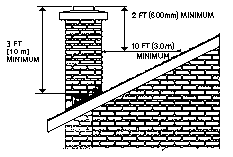Masonry Chimney Concerns:
Virtually every building or home has at least one
chimney. They have the potential to provide warmth and heat to our families yet can also
be destructive to our possessions and loved ones. For the most part, they are one of the
most overlooked parts of our structures, and rarely are they built according to the local
building codes. This article takes a look at two major categories of chimneys, and
provides some quick guidance and notes for concerned professionals on what to look for
when assessing the condition of the chimney. The purpose is not to make experts out of you
- lets leave that to the properly certified, full time chimney service people. However,
the information may help raise your awareness of possible problems associated with
chimneys.
Purpose of a Chimney:
The purpose of both types of chimneys is to allow
combustion by-products to be vented away from the structure safely without causing damage
to the structure they are attached to. Both types of chimneys have many similarities. They
are constructed of similar materials and both are subject to many of the samebuilding code
requirements. Even though chimneys serving fireplaces, and chimneys serving appliances may
be venting different combustion by-products (for instance, a fireplace chimney may be
venting solid fuel by-products), they should both be designed and constructed to discharge
these by-products at a rate that does not adversely affect the combustion process and to
release the discharged material at a height and location that provides fire safety.
(Technical Notes on Brick Construction, 19B, Brick Institute of America, Januarv 1988.)
Common Building Code Requirements:
It is important to note that building code requirements
often vary on a local basis. Typically, the reference used for local building codes is
based upon the National Fire Protection Agencies 211 standard for chimneys, fireplaces,
vents, and solid fuel burning appliances. (The latest version was updated in 1996 and may
be obtained by calling 1-800-344-3555). A few of the codes which are typically universally
adopted include the following:
- The minimum chimney height for fire safety is the greater of
3 ft. above the highest point where the chimney penetrates the roofline, or 2 ft. higher
than any portion of the structure or adjoining structures within 10 ft. of the chinmey.

- A chimney flue shall not change in size or shape within 6
in. above or below any point where the chimney passes through a combustible floor,
ceiling, or roof component.
- Residential masonry chinmey wall thickness should be a
nominal 4 inches.
- Masonry chimneys should be lined. The selection of the
lining material should be appropriate for the class of chimney service and the type of
appliance to it in accordance with the terms of the appliance listing and the
manufacturers instructions.
- Chimney clearance from combustible material is a minimum of
2 in. except where the chimney is located outside the structure, in which case I in. is
acceptable.
- According to most building codes, flues may be constructed
to discharge their by-products with other flues as long as the following conditions are
met:
- The flues do not slope more than 30 degrees from vertical.
- The flues are discharging by-products of similar fuels (for
instance, you can't combine a flue venting gas by-products with one venting wood
by-products).
- When combining flues, the main discharge flue should be
sized for the maximum combined flow of both smaller flues.
If you have any other questions on chimneys
please contact the
SOLID/FLUE distributors located
nearest you or call the home office of SOLID/FLUE
616-940-8809. |